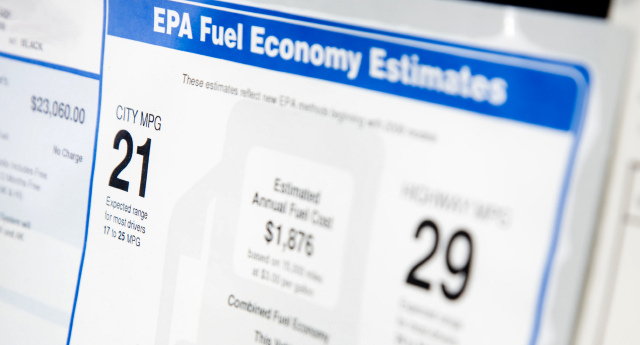President Obama is expected to unveil new fuel-economy standards for automobiles on Tuesday — the first major step by his administration to limit planet-warming greenhouse gases.
The new standards will reportedly raise fleet-wide standards for cars to 42 miles per gallon by 2016, up from 27.5 mpg now. For light trucks, the required fleet average will rise to about 26.2 mpg by 2016, up from about 24 mpg now. Ultimately, this will mean a 30 percent reduction in global-warming emissions from new vehicles by 2016, with improvements beginning in the 2011 model year. [Update: See below for clarification.]
The move will push the entire country to meet the aggressive standards proposed by the state of California. California and 13 other states had requested a waiver from the U.S. EPA that would allow them to set tougher auto-emissions standards than the federal government by requiring cars to reduce their emissions of carbon dioxide — and the only viable way to cut CO2 emissions is to require cars to get better gas mileage. The Bush administration denied California’s request last year, but Obama directed the EPA to reconsider the petition almost immediately after he took office.
The Obama administration will now officially grant California’s request for a waiver, and at the same time will adopt California’s standard for the whole country. This means fuel-economy and emissions standards will be combined into one straightforward set of rules.
Obama’s expected announcement would end what has been an ongoing dispute between auto manufacturers, states, and the federal government by creating a unified national standard. Automakers had complained that granting the California waiver would create two separate emissions standards for the country, as they are already required to meet national fuel-economy standards — also known as corporate average fuel economy or CAFE standards — set by the Department of Transportation’s National Highway Traffic Safety Administration (NHTSA).
The announcement will also be an opening move for the EPA in its fight against global warming. Last month, the agency indicated that it intends to begin regulating greenhouse-gas emissions under the Clean Air Act, having determined that planet-warming gases threaten human health. EPA’s first target was expected to be mobile sources — i.e., cars and trucks — which account for 20 percent of all U.S. emissions.
The move will please the Auto Alliance, the major industry group representing car makers, which has been asking for one standard that unifies emission and fuel-economy standards across the whole country.
“We recognize that greenhouse-gas emissions from automobiles need to be reduced,” Charles Territo, a spokesperson for the Alliance, told Grist last month. “At the end of the day, what’s most important is that we have a single, national standard that is achievable, but that is aggressive and cost-effective.”
Enviros are pleased too. “This is a very big deal,” Daniel Becker of the Safe Climate Campaign told The New York Times. “This is the single biggest step the American government has ever taken to cut greenhouse-gas emissions.” Daniel Weiss, director of climate strategy at the Center for American Progress, agrees: “The new clean car standard being announced tomorrow by President Barack Obama is a triple play: It will help move America off foreign oil, save families money, and spur American businesses to take the lead in developing the job-creating, clean-energy technologies of the future.”
Sierra Club Executive Director Carl Pope is happy too: “President Obama is putting the pedal to the floor when it comes to slashing our dependence on oil and confronting global warming. Today’s announcement is one of the most significant efforts undertaken by any president, ever, to end our addiction to oil and seriously slash our global warming emissions. The speed with which the Obama administration is moving to build the clean energy economy has been breathtaking.”
We’ll have more on the announcement soon, so stay tuned.
UPDATE: The White House held a background briefing with a senior administration official on the proposed rule change Monday evening. The official said that the administration will announce a notice of proposed rulemaking tomorrow that will call for an average annual fuel economy increase of 5 percent. That will bring cars up to 39 miles per gallon by 2016 and light trucks to 30 miles per gallon.
The official clarified that the Environmental Protection Agency has not yet decided whether or not to grant the California waiver. They have, however, reached an agreement with California, car makers, and the relevant federal agencies, and under that deal the state “will defer to national policy and not set a separate standard” through model year 2016 even if the waiver is granted. Thus, their current request for a waiver is pretty much moot, but California could decide to petition for higher standards for later model years.
Another significant change is that the new standards will include tougher requirements for each class size of vehicles, as well as a higher average across each company’s fleet, according to the official. The previous rules covered only the fleet average, which meant that companies could offset a giant SUV with some more fuel-efficient models.
“This has the effect of preserving consumer choice,” said the official. “You can continue to buy whatever size car you like, all cars get cleaner.”
The official also estimated that this emissions reductions from the CAFE increase will equate to taking 177 million cars off the road, or shutting down 194 coal-fired power plants.



